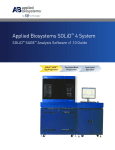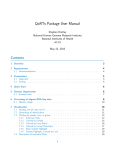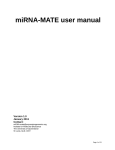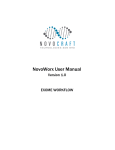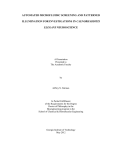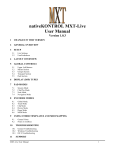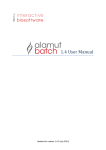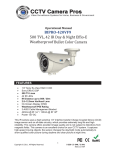Download RNA-MATE user manual - Expression Genomics Laboratory
Transcript
RNA-MATE user manual (preliminary documentation) Version 1.01 March 2009 Contact: Nicole Cloonan [email protected] Institute for Molecular Bioscience The University of Queensland St Lucia, QLD, 4072 Page 1 of 17 License: Copyright © 2008, 2009 Nicole Cloonan, Qinying Xu, Geoffrey Faulkner, and Sean Grimmond. This program is free software: you can redistribute it and/or modify it under the terms of the GNU General Public License as published by the Free Software Foundation, either version 3 of the License, or (at your option) any later version. This package is distributed in the hope that it will be useful, but WITHOUT ANY WARRANTY; without even the implied warranty of MERCHANTABILITY or FITNESS FOR A PARTICULAR PURPOSE. See the GNU General Public License for more details. You should have received a copy of the GNU General Public License along with this program. If not, see <http://www.gnu.org/licenses/>. Page 2 of 17 Table of Contents License 2 The RNA-MATE pipeline 4 General Description 4 Part 1: Quality checking of the tag (optional) 5 Part 2: Recursive alignment to the human or mouse genome 5 Part 3: Multi-mapping tag rescue (optional) 5 Part 4: Creation of visualization files 5 Availability 6 Requirements 6 Installation 6 Scripts 7 Master script: rna-mate-v1.01.pl 7 Configuration file 7 Configuration options 8 Modules 11 Log File 12 Module inputs and outputs 13 Modifying the pipeline to work with other queues 17 Optimizing performance on your cluster 17 Page 3 of 17 The RNA-MATE pipeline General Description For mammalian genomes, there are technical challenges associated with mapping and counting short-tag sequences derived from high-throughput sequencing data. Firstly, mammalian transcripts are non-contiguous due to the splicing of introns from the premRNA. This means that there will be a portion of tags that cross exon-exon boundaries that will not map directly to the genome. The ability to use short tag information relies directly upon being able to place short tags uniquely within the genome. The presence of genome wide repeats and other repetitive sequence in the mouse and human genomes mean that a sizeable proportion of short tags can not be placed uniquely. Finally, the random fragmentation of mRNA creates a distribution of sizes, of which a significant proportion will be less than the full length of the tag, and these will contain adaptor sequence that will not map to the genome. Here we present a computational pipeline to map RNAseq data, which generates both tag counting and genome-browser visualization of genomic and exon-junction matching results. RNA-MATE (Mapping and Alignment Tool for Expression) is designed for the rapid mapping of data from the Applied Biosystems SOLiD system (Figure 1). Start 1 Read Configuration File check quality? Yes Quality Check No Genome/Junction Alignment 2 tag aligned? No Trim Tag Yes rescue multimappers? 3 4 Yes No Select Single Mapping Tags Multimapping Tag Rescue Create Wiggle Plot Files Create Junction BED files End Figure 1. The RNA-MATE recursive mapping pipeline. The pipeline consists of 4 major components. (1) The optional tag quality module filters tags based on the quality values for each basecall. (2) The alignment module attempts to align tags first to the genome, and then to a library of known exon-junction sequences. If a tag fails to align, then the tag is truncated, and the process is repeated. (3) The optional tag rescue module is uses information derived from both singlemapping and multi-mapping tags to uniquely place multi-mapping tags. (4) Finally, UCSC genome browser compatible wiggle plots and BED files are generated. Page 4 of 17 Part 1: Quality checking of the tag (optional) Depending on the downstream applications of the matched data the quality of individual tags may need to be assessed before their inclusion in the mapping pipeline. To accommodate this, we have provided an optional tag quality module which assesses the tags by the number of basecalls with PHRED scores of less than 10. Tags that pass the QC are fed into the recursive alignment module. If this option is disabled, all tags are passed to the alignment module. Part 2: Recursive alignment to the human or mouse genome Alignment of the short tags to a reference genome is done using mapreads (http://solidsoftwaretools.com/gf/project/mapreads/), an algorithm specifically designed for the rapid mapping of data from the Applied Biosystems SOLiD system (ie. color-space data). Tags are first matched against all chromosomes of the reference genome, and then against a library of known exon-junctions (hg18 and mm9 are currently supported). Tags that fail to map to the genome or junctions are chopped to user defined lengths, and the genomic mapping is restarted. In this way, tags that have adaptor sequence, or poor quality ends are recovered at their longest length. The number of mismatches between the reference and tag is user defined, and when mappings from all tags are collated into a single file, only the mappings at the highest level of stringency are retained. Part 3: Multi-mapping tag rescue (optional) For most downstream applications, tags are only informative if they can be placed uniquely within a genome. Tags that align to multiple places within a genome make up a sizeable proportion of transcriptome derived tags, primarily from the inherent redundancy of the genome, but also from CpG islands and genome wide repeat elements. Strategies to rescue ambiguous sequences have recently been applied to high-throughput sequencing data, and we have refined our previously published algorithm to work efficiently with large data sets. For every multimapping tag, the algorithm considers all tags that map near to each of the possible locations of the tag (within a user-specified window) to determine the most likely mapping position of the tag. Where a tag can not be unambiguously assigned, a fractional weighting to the relevant positions is assigned. In practice, between 40-60% of multi-mapping tags can be assigned a single position with ≥60% likelihood, depending on the relative sequence coverage. The recommended window size for shotgun sequencing is 10 (Cloonan, et al., 2008), whereas the window recommended for CAGE data and other disparate data sets is X (ref?). Part 4: Creation of visualization files Finally, UCSC genome browser compatible wiggle plots for genome mapped data, and BED files for exon-junction mapped data are generated automatically from the collated results. The wiggle plots are strand-specific, single-nucleotide resolution coverage plots, and directly represent the number of times an individual nucleotide has been seen in the sequencing data. BED files depict hits to junction sequences, and graphically display exon combinatorics. In addition, plots containing only start sites of tags are included to facilitate tag-counting applications. Page 5 of 17 Availability All source code, documentation, and associated files described in this manual are freely available for download from: http://grimmond.imb.uq.edu.au/RNA-MATE/ or http://solidsoftwaretools.com/gf/project/rnamate/ Requirements This pipeline is written predominantly in perl (with some python thrown in for good measure), and requires that you have version 5.8.8 of perl or later, and python version 2.4 or later. It is designed to run in a unix environment, with a PBS queue manager. The scripts can be modified to work with an LSF or SGE manager. It is not recommended to run this pipeline on a system without access to a cluster due to the large computational requirements of mapping to mammalian genomes – however, the scripts could potentially be modified to do this. You will need to install the ForkManager.pm perl module if you do not already have it, as well as Path-Class-0.16. Both are available from CPAN. The alignment section of this pipeline is dependant upon the mapreads tool, available from: http://solidsoftwaretools.com/gf/project/mapreads/. Installation Simply unzip the tarball and add the path of the installation directory to @INC using the command: export PERL5LIB=${PERL5LIB}:/[full path]/RNA-MATEv1.0/perl/ This can be added to the ~/.bash_profile or ~/.profile files for automatic loading, or it can be added to the default profile for all users. The script mask_schemas_mapreads.pl should be placed in the same folder as the mapreads program. Page 6 of 17 Scripts Master script: rna-mate-v1.01.pl This script will call the required modules in order. There is only one user-defined parameter for this script, which allows you to specify a configuration file containing all the required parameters for the entire mapping pipeline. To run this script, use the following command: [path]/rna-mate-v1.01.pl –c [configuration file] Configuration file The configuration file is a text file containing all the required parameters to run RNA-MATE. In this file, directory listings must end with a “/”, there must be no other punctuation at the end of the lines, and there should be no empty lines in this file. An example of the configuration file is given below: max_length_tag=35 tag_length=35,30 num_mismatch=3 mask=11111111111111111111111111111111111 max_multimatch=10 expect_strand=+ rescue_window=10 exp_name=tag_20000_F3 chromosomes=chrM,chr2 chr_path=/data/matching/hg18_fasta/ junction=/data/matching/libraries/hg18_junctions_best_quality.fas ta.cat junction_index=/data/matching/libraries/hg18_junctions_best_quali ty.fasta.index output_root=/data/cxu/ output_dir=/data/cxu/tag_20000_F3/ raw_qual=/data/raw/tag20000.qual raw_csfasta=/data/raw/tag20000.csfasta status_out=/data/cxu/tag_20000_F3/total_rep2/map_status.out raw_csfasta=/data/cxu/tag_20000_F3/total_rep2.csfasta [email protected] run_rescue=false num_parallel_rescue=4 quality_check=true script_chr_start=/data/matching/chr_start.pl script_chr_wig=/data/matching/chr_wig.pl f2m=/data/matching/f2m.pl mapreads=/data/matching/mapreads rescue=/data/matching/chr_rescueSOLiD.py master_script=/data/matching/rna-mate-v1.01.pl Page 7 of 17 Configuration options max_length_tag=35 This parameter defines the longest length of the tags contained in the csfasta file. tag_length=35,30 This parameter defines the lengths at which matching will occur recursively. Lengths should be in multiples of 5nt. The minimum recommended length for transcriptome data is 30nt although this will depend on how many mismatches you allow. For up to 3 mismatches to a mammalian genome, the minimum length should be 30nt because even though you still get a large proportion of single mapping tags at this length, the specificity is very poor. If you allow up to 1 mismatch, then you can still achieve good sensitivity at 25nt. For other smaller genomes, the minimum acceptable matches should be determined on a case by case basis. num_mismatch=3 The number of mismatches permissible between the tag and the reference sequence. Currently this pipeline does not support the “valid adjacent error” feature of mapreads. This upgrade is planned for a future release. NOTE: Mapping schemas must be available to do the mapping at the specified length and number of mistmatches, or else the pipeline will fail. ie. in this example, the schemas required are: schema_35_3 schema_30_3 Mapping schemas are available from http://solidsoftwaretools.com/. mask=11111111111111111111111111111111111 This setting allows you to ignore particular bases in the tag when computing the number of mismatches. 1 = consider this base, 0 = do not consider this base. The length of the mask should equal the length of the longest tags. max_multimatch=10 Defines the maximum number of positions to be reported for multi-mapping tags. The higher this number, the more disk space is required to store the data, and the slower the program will run. Recommended size for most applications is 10. Page 8 of 17 expect_strand=+ This defines the strandedness of the data. For example, libraries made with the SREK protocol or other direct ligation protocols will have tags that are sequenced in the sense (+) strand relative to the expressed gene. Libraries made with the SQRL protocol will have tags that are sequenced in the antisense (-) relative to the expressed gene. rescue_window=10 This parameter defines the window size used for multi-map tag rescue. The recommended setting for shotgun sequencing data is 10, whereas the recommended setting for CAGE and other disparate data sets is 100. exp_name=tag_20000_F3 Set the experiment name with this parameter. chromosomes=chrM,chr2 Defines the names of the chromosomes to map against. The filenames are expected to be: [chromosome_name].fa chr_path=/data/matching/hg18_fasta/ The full path of the chromosome fasta files. junction=/data/matching/libraries/hg18_junction.fasta.cat The full path of the junction library against which you can map. junction_index=/data/matching/libraries/hg18_junction.fasta.index The full path of the junction index file. output_root=/data/cxu/ output_dir=/data/cxu/tag_20000_F3/ The full paths of the output root and output directories. raw_qual=/data/raw/tag20000.qual The full path of the QV file. Page 9 of 17 raw_csfasta=/data/raw/tag20000.csfasta The full path of the csfasta file to be matched. status_out=/data/cxu/tag_20000_F3/total_rep2/map_status.out Not used in this implementation of RNA-MATE. [email protected] Not used in this implementation of RNA-MATE. run_rescue=true This parameter allows you to turn on or off the rescue of multi-mapping tags module. Acceptable values are “true” or “false”. True = run multi-map rescue, false = do not run multi-map rescue. NOTE: multi-map rescue can be a very memory intensive process. Rescue for a single chromosome of a transcriptome dataset with > 100 million mappable tags can consume more than 20 Gb of resident memory. The amount of memory used will depend on the size of the data set, the number of multi-mapping tags versus single mapping tags, the underlying complexity of the data set, and the number of positions of each tag to be rescued. num_parallel_rescue=4 This parameter allows you to adjust the number of rescue jobs that are run in parallel. The settings chosen here will depend on the amount of memory available on your system, the number of CPUs available, and the amount of memory consumed by the rescue (see the note above regarding multi-mapping tag rescue and memory usage). quality_check=true This parameter allows you to turn on or off the quality checking of tags module. Acceptable values are “true” or “false”. True = run quality check, False = do not run quality check. script_chr_start=/data/matching/chr_start.pl script_chr_wig=/data/matching/chr_wig.pl f2m=/data/matching/f2m.pl mapreads=/data/matching/mapreads rescue=/data/matching/chr_rescueSOLiD.py master_script=/data/matching/ rna-mate-v1.01.pl These parameters define the full path showing the location of the various scripts required to run RNA-MATE. Page 10 of 17 Modules tools_mapping.pm This module includes four functions: creating log files; checking whether the jobs on the queue are finished; creating new csfasta files”; and chopping tags for recursive mapping. tag_quality.pm This module checks tag quality, making sure that each tag contains less then five nucleotides where the QV value for that basecall is less than 10 (PHRED scale). Currently this threshold is hardcoded. Future implementations will allow user defined values at this point. mapping.pm This module automatically arranges genome and junction mapping for different tag lengths. single_selection.pm This module attempts to select a single mapping position for each tag based on the mapping results at the highest stringency. For example, if a tag maps once with zero mismatches, and 3 times with one mismatch, then the tag is recorded as a single mapping tag at a stringency of zero mismatches. new_rescue.pm This module use new version rescue program which can parallel rescue for each chromosome and use less memory. wiggle_plot.pm: This module creates strand specific wiggle plot (or bedGraph) files for visualization in the UCSC genome browser. This module also creates “start site plots” which facilitates tag counting applications. UCSC_junction.pm. This module creates BED files for displaying exon-junction usage in the UCSC genome browser. Page 11 of 17 Log File tag_20000_F3.log This is an example of the output log file for the tag_20000_F3 experiment. Each status output includes two lines, the first line is system time and the second is what the system doing at that time. Mon Nov 17 13:45:41 2008 [PROCESS]: Welcome to our mapping strategy system! Mon Nov 17 13:45:42 2008 [SUCCESS]: Created csfasta file for different tag length, in which tag quality is checked! Mon Nov 17 13:45:42 2008 [PROCESS]: mapping to all chromosomes Mon Nov 17 13:45:42 2008 waiting for queue Mon Nov 17 14:04:42 2008 [SUCCESS]: mapped to all chromosomes Mon Nov 17 14:04:42 2008 [PROCESS]: collating genome mers:35 Mon Nov 17 14:04:42 2008 [SUCCESS]: collated genome mers:35 Mon Nov 17 14:04:42 2008 [PROCESS]: mapping to junction Mon Nov 17 14:10:42 2008 [SUCCESS]: mapped to junction Mon Nov 17 14:10:42 2008 [PROCESS]: collating junction mers:35 Mon Nov 17 14:10:42 2008 [SUCCESS]: collated junction mers:35 Mon Nov 17 14:10:42 2008 [PRPCESS]: chopping tag Mon Nov 17 14:10:42 2008 [PROCESS]: mapping to all chromosomes Mon Nov 17 14:10:42 2008 waiting for queue Mon Nov 17 14:28:42 2008 [SUCCESS]: mapped to all chromosomes Mon Nov 17 14:28:42 2008 [PROCESS]: collating genome mers:30 Mon Nov 17 14:28:42 2008 [SUCCESS]: collated genome mers:30 Mon Nov 17 14:28:42 2008 [PROCESS]: mapping to junction Mon Nov 17 14:33:42 2008 [SUCCESS]: mapped to junction Mon Nov 17 14:33:42 2008 [PROCESS]: collating junction mers:30 Mon Nov 17 14:33:42 2008 [SUCCESS]: collated junction mers:30 Mon Nov 17 14:33:42 2008 [PROCESS]: rescue multi mapped tags Mon Nov 17 14:33:42 2008 Page 12 of 17 [SUCCESS]: Mon Nov 17 [PROCESS]: Mon Nov 17 [SUCCESS]: Mon Nov 17 [SUCCEED]: rescue tags are done! 14:33:42 2008 prepare data for wiggle plot... 14:33:42 2008 prepared data file for parallel wig plot. 14:33:42 2008 all done! enjoy the data! Module inputs and outputs This section details the input and output files generated from each of the modules in this pipeline for the tag_20000_F3 experiment with the configuration file as above. tools_mapping.pm sub create_csfata input: tag20000_F3.csfasta output: tag_20000_F3.mers35.unique.csfasta tag_20000_F3.mers30.unique.csfasta mapping.pm (35mers) sub genomic_mapping (35) input: tag_20000_F3.mers35.unique.csfasta output: chr2.tag_20000_F3.mers35.unique.csfasta.ma.35.3 chrM.tag_20000_F3.mers35.unique.csfasta.ma.35.3 sub collate_genomic_matches (35) input: chr*.mers35.*.3 output: tag_20000_F3.mers35.genomic.collated tag_20000_F3.mers35.genomic.non_matched sub junction_mapping (35) input: tag_20000_F3.mers35.genomic.non_matched output: hg18_junctions_best_quality.tag_20000_F3.mers35.genom ic.non_matched.ma.35.3 sub collate_junction_matches (35) input: hg18_junctions_best_quality.tag_20000_F3.mers35.genom ic.non_matched.ma.35.3 output: tag_20000_F3.mers35.junction.non_matched Page 13 of 17 tools_mapping.pm sub chop_tag input: tag_20000_F3.mers35.junction.non_matched tag_20000_F3.mers30.unique.csfasta output: tag_20000_F3.mers30.unique.csfasta mapping.pm (30mers) sub genomic_mapping (30) input: tag_20000_F3.mers30.unique.csfasta output: chr2.tag_20000_F3.mers30.unique.csfasta.ma.30.3 chrM.tag_20000_F3.mers30.unique.csfasta.ma.30.3 sub collate_genomic_matches (30) input: chr*30.*.3 output: tag_20000_F3.mers30.genomic.collated tag_20000_F3.mers30.genomic.non_matched sub junction_mapping (30) input: tag_20000_F3.mers30.genomic.non_matched output: hg18_junctions_best_quality.tag_20000_F3.mers30.genom ic.non_matched.ma.30.3 sub collate_junction_matches (30) input: hg18_junctions_best_quality.tag_20000_F3.mers30.genom ic.non_matched.ma.30.3 output: tag_20000_F3.mers30.junction.non_matched single_select.pm input: tag_20000_F3.mers35.genomic.collated tag_20000_F3.mers30.genomic.collated output: tag_20000_F3.mers30.genomic.stats tag_20000_F3.mers35.genomic.stats chr2.tag_20000_F3.for_wig.negative chr2.tag_20000_F3.for_wig.positive chrM.tag_20000_F3.for_wig.negative chrM.tag_20000_F3.for_wig.positive wiggle_plot.pm sub paralle_wig_fork input: chr2.tag_20000_F3.for_wig.negative chr2.tag_20000_F3.for_wig.positive Page 14 of 17 chrM.tag_20000_F3.for_wig.negative chrM.tag_20000_F3.for_wig.positive output: chr2.tag_20000_F3.for_wig.negative.sorted chr2.tag_20000_F3.for_wig.negative.wig chr2.tag_20000_F3.for_wig.negative.wig.success chr2.tag_20000_F3.for_wig.positive.sorted chr2.tag_20000_F3.for_wig.positive.wig chr2.tag_20000_F3.for_wig.positive.wig.success chrM.tag_20000_F3.for_wig.negative.sorted chrM.tag_20000_F3.for_wig.negative.wig chrM.tag_20000_F3.for_wig.negative.wig.success chrM.tag_20000_F3.for_wig.positive.sorted chrM.tag_20000_F3.for_wig.positive.wig chrM.tag_20000_F3.for_wig.positive.wig.success sub start_plot_fork input: chr2.tag_20000_F3.for_wig.negative chr2.tag_20000_F3.for_wig.positive chrM.tag_20000_F3.for_wig.negative chrM.tag_20000_F3.for_wig.positive output: chr2.tag_20000_F3.for_wig.negative.starts chr2.tag_20000_F3.for_wig.negative.starts.success chr2.tag_20000_F3.for_wig.positive.starts chr2.tag_20000_F3.for_wig.positive.starts.success chrM.tag_20000_F3.for_wig.negative.starts chrM.tag_20000_F3.for_wig.negative.starts.success chrM.tag_20000_F3.for_wig.positive.starts chrM.tag_20000_F3.for_wig.positive.starts.success tag_20000_F3.negative.starts tag_20000_F3.positive.starts sub collect_data input: chr2.tag_20000_F3.for_wig.negative.starts chr2.tag_20000_F3.for_wig.positive.starts chr2.tag_20000_F3.for_wig.negative.wig chr2.tag_20000_F3.for_wig.positive.wig chrM.tag_20000_F3.for_wig.negative.wig chrM.tag_20000_F3.for_wig.positive.wig chrM.tag_20000_F3.for_wig.negative.starts chrM.tag_20000_F3.for_wig.positive.starts output: tag_20000_F3.negative.wiggle tag_20000_F3.positive.wiggle UCSC_junction.pm sub single_selection (35) input: hg18_junctions_best_quality.tag_20000_F3.mers35.genom ic.non_matched.ma.35.3 output: tag_20000_F3.junction35.negative.stats Page 15 of 17 tag_20000_F3.junction35.positive.stats tag_20000_F3.junction35.single_map.negative tag_20000_F3.junction35.single_map.positive sub search_junctionID (positive file) input: tag_20000_F3.junction35.single_map.positive output: tag_20000_F3.junction35.single_map.positiveID sub search_junctionID (negative file) input: tag_20000_F3.junction35.single_map.negative output: tag_20000_F3.junction35.single_map.negativeID sub single_selection (30) input: hg18_junctions_best_quality.tag_20000_F3.mers30.genom ic.non_matched.ma.30.3 output: tag_20000_F3.junction30.negative.stats tag_20000_F3.junction30.positive.stats tag_20000_F3.junction30.single_map.negative tag_20000_F3.junction30.single_map.positive sub search_junctionID (positive file) input: tag_20000_F3.junction30.single_map.positive output: tag_20000_F3.junction30.single_map.positiveID sub search_junctionID (negative file) input: tag_20000_F3.junction30.single_map.negative output: tag_20000_F3.junction30.single_map.negativeID sub create_BED (positive file) input: tag_20000_F3.junction30.single_map.positiveID tag_20000_F3.junction35.single_map.positiveID output: tag_20000_F3.positive.junction.BED sub create_BED (negative file) input: tag_20000_F3.junction30.single_map.negativeID tag_20000_F3.junction35.single_map.negativeID output: tag_20000_F3.negative.junction.BED Page 16 of 17 Modifying the pipeline to work with other queues In order to make this program compatible with other queue managers the mapping.pm module will need to be edited. Specifically, lines in the genome_mapping and junction_mapping subroutines that contain: $comm = "qsub -l walltime=48:00:00,ncpus=2 $mysh.err $mysh > $mysh.id "; -o $mysh.out -e will need to be replaced with the appropriate job submission commands and parameters that are specific to your system. Till Bayer (from the MPI for Evolutionary Biology in Germany) has kindly provided instructions on modifying this script to work on SGE systems. The line above should be changed to: $comm = "qsub -l s_rt=48:00:00,s_cpu=2 -o $mysh.out -e $mysh.err $mysh > $mysh.id"; In addition to modifying the lines above, lines 76 and 133 which read: print OUT $comm; should be changed to include the “#$/bin/sh” line, and a newline after the actual command needs to be inserted. Optimizing performance on your cluster The script as written asks for two CPUs per mapping job. As mapreads is not parallelized, this is an inefficient, but necessary throttle if you are running an NFS file transfer protocol. The entire pipeline (including mapreads) is very I/O intensive, and depending on the setup, users may find that NFS will timeout if too much is asked of it. For systems using less archaic protocols this will not be necessary, and the script can be modified to request a single CPU. Page 17 of 17

















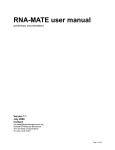


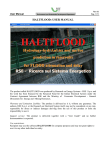
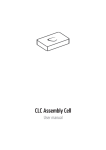


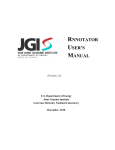


![Identifying Embeded Web Servers - [media.blackhat.com]](http://vs1.manualzilla.com/store/data/005833288_1-dd26f65aacb79f754f7b5aa134b8197a-150x150.png)

